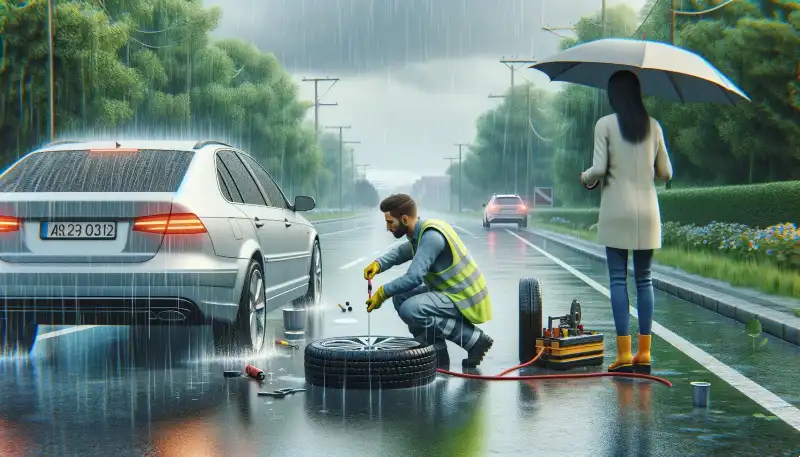Experiencing a vehicle breakdown can be stressful, but prioritizing your safety while waiting for roadside assistance is crucial. Here are some detailed tips to help you stay secure:
1. Position Your Car Safely
If possible, move your vehicle to the side of the road, away from traffic. Choose a flat, stable surface and avoid stopping on curves or hills where visibility is limited. If you’re on a highway, try to reach the nearest exit. Always use your mirrors and signal your intentions to other drivers before moving.
Positioning your car safely not only ensures your own safety but also helps other drivers navigate around you without creating additional hazards. If you cannot move your car, stay inside and wait for roadside assistance to arrive.
2. Use Hazard Lights
Turn on your hazard lights immediately to alert other drivers of your situation. This helps increase your visibility and reduces the risk of an accident. If it’s dark or visibility is poor, keep your headlights on as well.
Hazard lights signal to other drivers that your vehicle is stationary and that they should proceed with caution. Using your hazard lights effectively can prevent further accidents and keep you safe while you wait for roadside assistance.
3. Stay Inside the Vehicle
Unless there’s a threat to your safety inside the vehicle, it’s generally safer to stay inside. Keep your seatbelt fastened and lock the doors. This protects you from passing traffic and other potential dangers outside.
Staying inside your vehicle minimizes the risk of being hit by passing cars, especially on busy roads or highways. It also provides a barrier against any external threats while you await roadside assistance.
4. Set Up Reflective Triangles
If you have reflective triangles or flares, place them behind your vehicle to provide additional warning to oncoming traffic. Place the first triangle about 10 feet behind the car, the second about 100 feet, and the third about 200-300 feet, especially if you’re on a highway.
Reflective triangles increase your visibility to other drivers, helping them see your vehicle from a distance and giving them ample time to slow down and pass safely. This is particularly important at night or in poor weather conditions. Use these tools to enhance your safety while waiting for roadside assistance.
5. Call for Help
Use your mobile phone to contact roadside assistance immediately. Provide them with accurate information about your location and the nature of your breakdown. Use landmarks, mile markers, or GPS coordinates to help them find you quickly.
Having precise location information can significantly reduce the time it takes for roadside assistance to reach you. Be clear and concise when explaining your situation to ensure that the help you need is dispatched promptly.
6. Stay Visible
If you must exit your vehicle, wear a reflective vest if available. Stay alert and be mindful of oncoming traffic, especially at night or in poor weather conditions. Avoid standing behind or in front of your vehicle.
Visibility is crucial for your safety when you’re outside your vehicle. Reflective clothing and cautious behavior can prevent accidents and ensure that other drivers see you while you’re waiting for roadside assistance.
7. Keep Emergency Supplies Handy
Carry an emergency kit in your car that includes items like a flashlight, first aid supplies, water, non-perishable snacks, a blanket, and basic tools. These can be invaluable while you wait for assistance, especially in adverse conditions.
Being prepared with an emergency kit can make a significant difference in your comfort and safety during a breakdown. These supplies help you stay safe and comfortable until roadside assistance arrives.
8. Communicate Your Situation
Inform a friend or family member about your breakdown and your location. This ensures someone is aware of your situation and can check on you if needed. Share your estimated time of arrival and any changes to your plans.
Having someone else aware of your situation adds an extra layer of security. If there’s any delay in roadside assistance, your contact can follow up and ensure you’re safe.
9. Use Caution with Strangers
While most people are willing to help, it’s important to be cautious. If a stranger offers assistance, remain inside your vehicle and speak through a slightly opened window. Politely decline help and let them know that professional assistance is on the way.
Safety first—it’s always best to wait for professional roadside assistance rather than accepting help from strangers. This approach minimizes risks and ensures you’re getting the right help.
10. Monitor Weather Conditions
If you’re stranded in extreme weather conditions, take appropriate measures to stay warm or cool. Use blankets or turn on the car’s heater for short intervals to conserve fuel in cold weather. In hot weather, open windows slightly for ventilation and stay hydrated.
Weather conditions can drastically affect your safety and comfort. Be proactive in managing your environment while waiting for roadside assistance to ensure you remain safe and comfortable.
Summary
By following these tips, you can ensure your safety while waiting for roadside assistance. Prioritizing your security and being well-prepared can significantly reduce the stress and risks associated with vehicle breakdowns. Whether it’s positioning your car safely, using hazard lights effectively, or keeping emergency supplies handy, each step contributes to a safer experience. And remember, for reliable roadside assistance in Auckland, our team is just a call away, ready to provide professional help when you need it most. For more guides to roadside assistance check out our everything you need to know about roadside assistance in Auckland guide here >>
Contact Roadside Assistance
For immediate roadside assistance, contact our emergency call-out service. Our expert team is ready to help you get back on the road quickly and safely.

